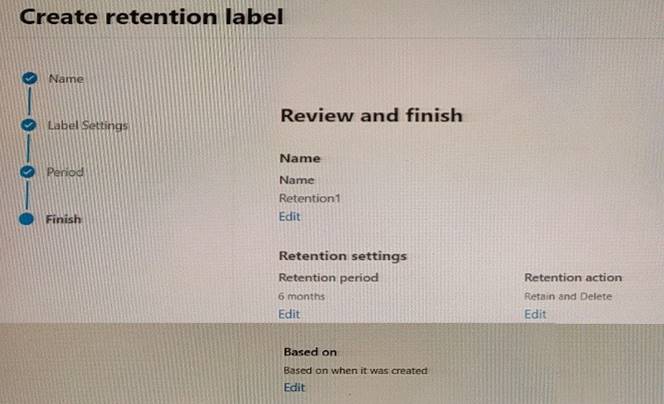Question 61
HOTSPOT - (Topic 2)
You need to meet the technical requirement for log analysis.
What is the minimum number of data sources and log collectors you should create from Microsoft Cloud App Security? To answer, select the appropriate options in the answer area.
NOTE: Each correct selection is worth one point.
Solution:
References:
https://docs.microsoft.com/en-us/cloud-app-security/discovery-docker
Does this meet the goal?
Correct Answer:A
Question 62
HOTSPOT - (Topic 6)
You have three devices enrolled in Microsoft Endpoint Manager as shown in the following table.
The device compliance policies in Endpoint Manager are configured as shown in the following table.
The device compliance policies have the assignments shown in the following table.
For each of the following statements, select Yes if the statement is true. Otherwise, select No. NOTE: Each correct selection is worth one point.
Solution:
Does this meet the goal?
Correct Answer:A
Question 63
HOTSPOT - (Topic 6)
HOTSPOT
You have a Microsoft 365 E5 tenant that contains the users shown in the following table.
The tenant contains the devices shown in the following table.
You have the apps shown in the following table.
You plan to use Microsoft Endpoint Manager to manage the apps for the users.
For each of the following statements, select Yes if the statement is true. Otherwise, select No.
NOTE: Each correct selection is worth one point.
Solution:
Does this meet the goal?
Correct Answer:A
Question 64
- (Topic 6)
You have a Microsoft 365 E5 subscription that contains the resources shown in the following table.
You create a sensitivity label named Label1. To which resource can you apply Label1?
Correct Answer:E
Assign sensitivity labels to Microsoft 365 groups in Azure Active Directory
Azure Active Directory (Azure AD), part of Microsoft Entra, supports applying sensitivity labels published by the Microsoft Purview compliance portal to Microsoft 365 groups.
In addition to using sensitivity labels to protect documents and emails, you can also use sensitivity labels to protect content in the following containers: Microsoft Teams sites, Microsoft 365 groups (formerly Office 365 groups), and SharePoint sites.
When you configure a label policy, you can:
Choose which users and groups see the labels. Labels can be published to any specific user or email-enabled security group, distribution group, or Microsoft 365 group (which can have dynamic membership) in Azure AD.
Reference:
https://learn.microsoft.com/en-us/microsoft-365/compliance/sensitivity-labels-teams- groups-sites
https://learn.microsoft.com/en-us/microsoft-365/compliance/sensitivity-labels?view=o365- worldwide
Question 65
- (Topic 6)
You have a Microsoft 365 subscription.
You create a retention label named Retention1 as shown in the following exhibit.
You apply Retention! to all the Microsoft OneDrive content.
On January 1, 2020, a user stores a file named File1 in OneDrive.
On January 10, 2020, the user modifies File1. On February 1, 2020, the user deletes File1.
When will File1 be removed permanently and unrecoverable from OneDrive?
Correct Answer:B
Question 66
- (Topic 6)
Your on-premises network contains an Active Directory domain.
You have a Microsoft 365 subscription.
You need to sync the domain with the subscription. The solution must meet the following requirements:
On-premises Active Directory password complexity policies must be enforced. Users must be able to use self-service password reset (SSPR) in Azure AD. What should you use?
Correct Answer:D
Azure Active Directory (Azure AD) Pass-through Authentication allows your users to sign in to both on-premises and cloud-based applications using the same passwords.
This feature is an alternative to Azure AD Password Hash Synchronization, which provides the same benefit of cloud authentication to organizations. However, certain organizations
wanting to enforce their on-premises Active Directory security and password policies, can choose to use Pass-through Authentication instead.
Note: Azure Active Directory (Azure AD) self-service password reset (SSPR) lets users reset their passwords in the cloud, but most companies also have an on-premises Active Directory Domain Services (AD DS) environment for users. Password writeback allows password changes in the cloud to be written back to an on-premises directory in real time by using either Azure AD Connect or Azure AD Connect cloud sync. When users change or reset their passwords using SSPR in the cloud, the updated passwords also written back to the on-premises AD DS environment.
Password writeback is supported in environments that use the following hybrid identity models:
Password hash synchronization Pass-through authentication
Active Directory Federation Services
Reference:
https://docs.microsoft.com/en-us/azure/active-directory/hybrid/how-to-connect-pta https://docs.microsoft.com/en-us/azure/active-directory/authentication/concept-sspr-writeback